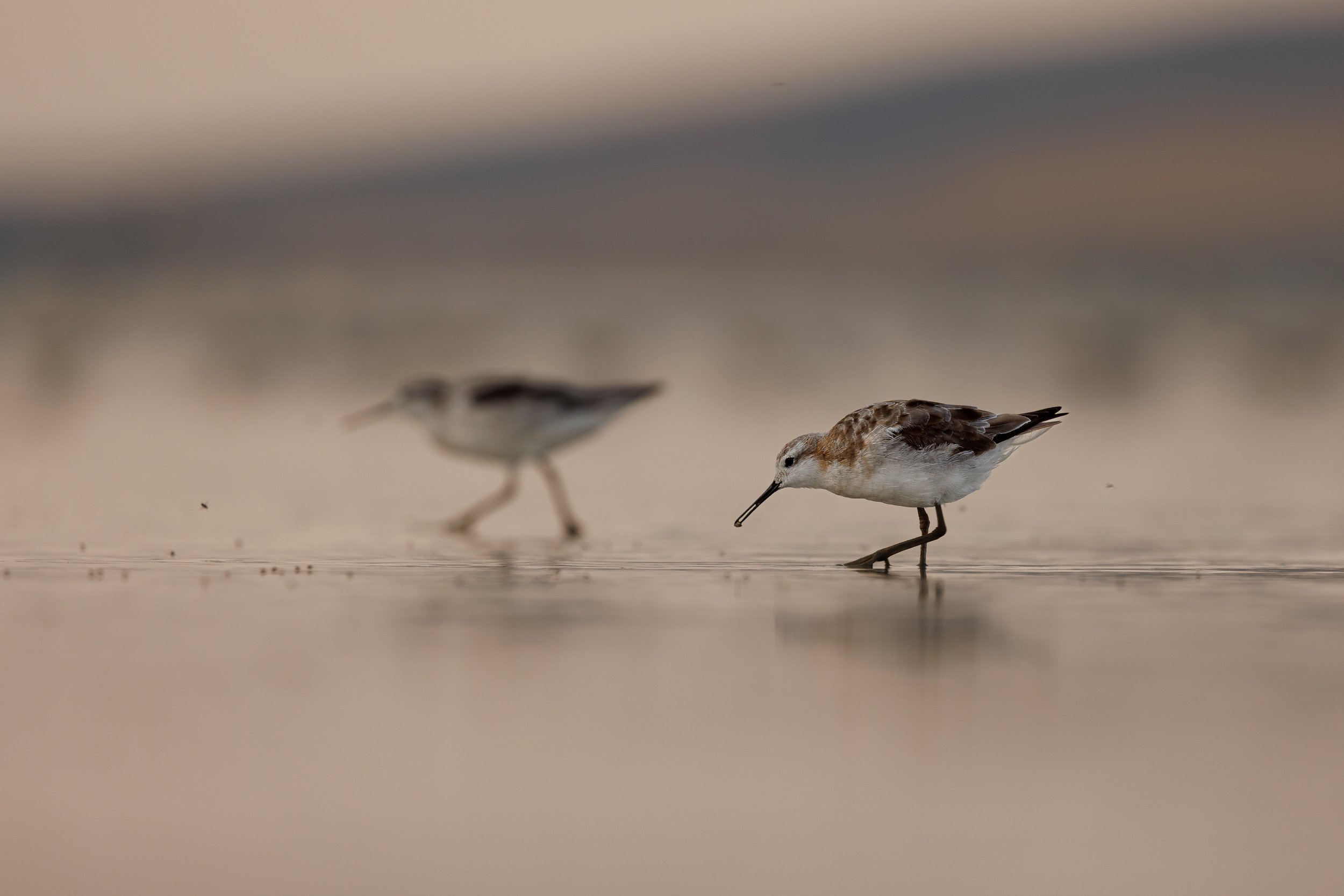Wings and Hands: Cultural Connection Through Shorebirds
On a Saturday morning in August, the rising sun illuminates the shoreline, and with each step we are reminded that we walk in the tracks of the shorebirds who brought us here. Great Salt Lake presents itself to us in the pungent brine that fills the air and the pastel colors that play across the water – the presence of life on the land is vibrant. We fill our lungs with this uniquely saline air and commit the glimmering snapshot of the landscape to memory. It is time to count shorebirds.
This blog has been provided in English & Spanish by author, Alhondra Lopez. Desliza hacia abajo para leer la traducción al español.
Red-necked and Wilson's Phalaropes foraging at Great Salt Lake. Photo by Janice Gardner.
Shorebirds are phenomenal beings that encourage us to learn more about the interconnection of our lives with the natural world and global communities. Many shorebirds undertake impressive migratory journeys, traveling thousands of miles across the hemisphere to reach different breeding and nonbreeding grounds, highlighting their resiliency, adaptability, and their remarkable endurance. Shorebirds also play a vital role in our ecosystems, contributing to the biodiversity of saline lakes, consuming billions of insects, and are impactful indicators of ecosystem health. Furthermore, as strong migratory birds, they also function as storytellers that connect us to other places and cultures. Shorebirds are ambassadors between communities; they inspire humans through birdwatching, folklore, and art, as well as creating connections between humans and nature.
One of these storytellers is the Wilson’s Phalarope, a small shorebird who travels roughly 4,000 miles from saline lake to saline lake while connecting communities across the Western Hemisphere. This incredible bird effectively creates relationships with people living and working in areas from Canada all the way to Laguna Mar Chiquita in Córdoba, Argentina.

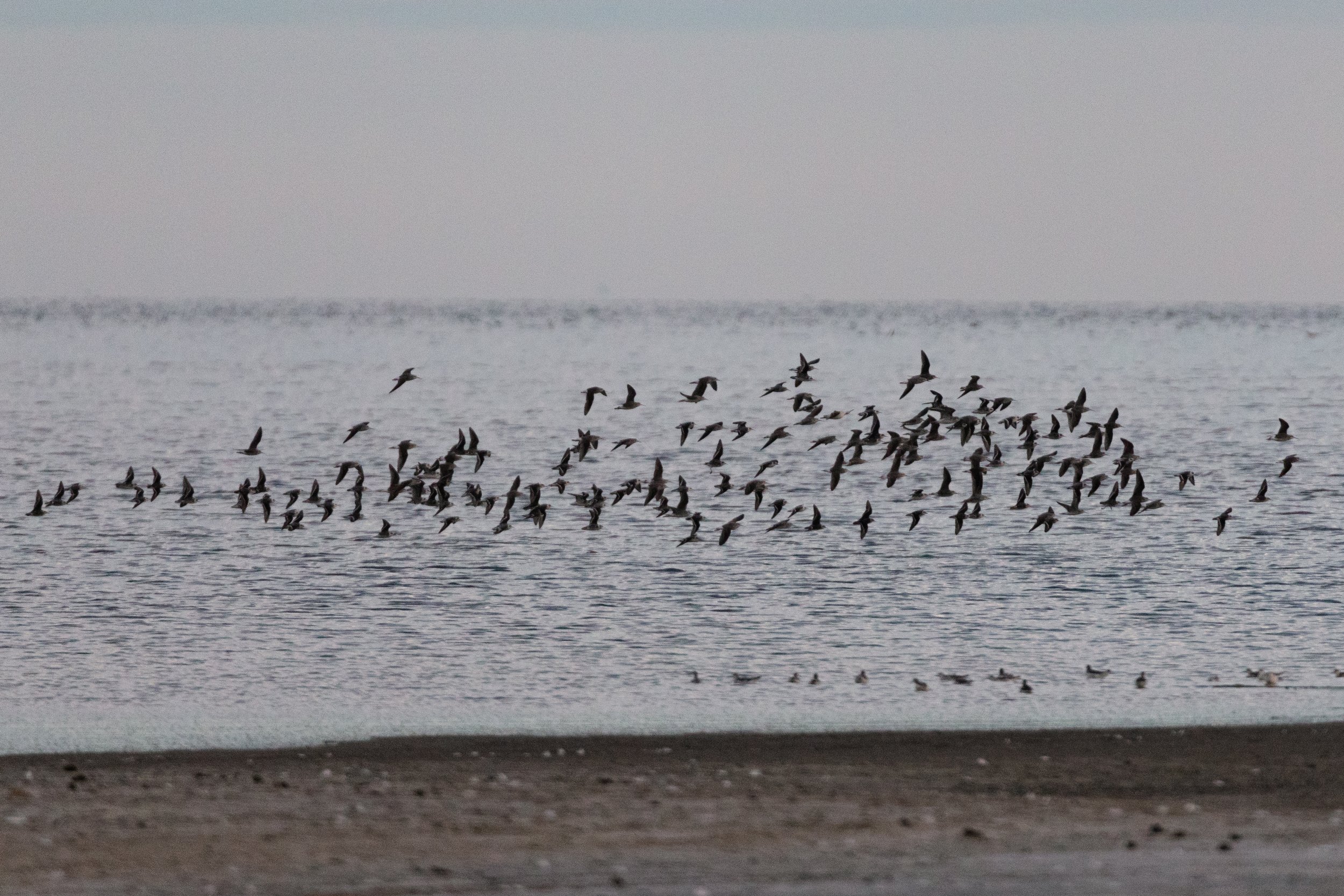

Butler (right) and Clark (behind, center) on a boat tour of Laguna Mar Chiquita. Photo by Jaimi Butler.
Sageland Collaborative’s Avian Ecologist, Emily (Emm) Clark, and Jaimi Butler, Chair of Sageland's Board of Directors, traveled to Argentina this past spring for a meeting of the International Phalarope Working Group, a multinational collaborative working to learn more about and conserve the three different species of phalarope. Of particular interest for Sageland is to strengthen and expand connections between our sister saline lakes and the people working to protect them. Our representatives also worked to develop flyway scale conservation efforts for phalaropes. This group has been making meaningful conservation impacts since 2019, and is committed to fostering connections and sharing experiences among various cultures and countries, including Chile, Bolivia, Ecuador, United States, Canada, and Argentina, in support of the conservation of phalaropes and saline habitats. Clark shares that this group formed to advance and coordinate research and conservation actions for phalaropes across the Western Hemisphere. “So far, the group has helped advance our knowledge about phalaropes through coordinated surveys in multiple regions, begun tracking studies to learn about migratory pathways, and supported international capacity building.” The group focuses their work through four action plans: research, monitoring, site management, and education.
For Clark, being connected to wildlife and the landscape also means being connected to people.
“I love seeing people come together to focus on creating better conditions for both people and other animals to thrive.”
This love of education, research, and conservation led Clark and Butler to be awarded a travel grant from the Linking Communities program to attend the International Phalarope Working Group meeting from February 26 - 29, 2024 in Miramar de Ansenuza, Córdoba, Argentina. This meeting was an opportunity to connect in person with partners working on saline lakes and other critical habitats for phalaropes across the western hemisphere. Along with attendees John Neill and John Luft from the Utah Division of Wildlife Resources, it was a great opportunity to share experiences and concerns from the Great Salt Lake, as well as discuss how to best support conservation efforts through education and outreach.
International Phalarope Working Group Meeting participants pose in front of a mural by artist Franco “Vato” Cervato Cozza, showing the migration of Wilson's Phalaropes between sister saline lakes. Photo by Emm Clark.
Butler admired the educational element of the event. Youth from the Experiencia Ambientalia environmental leadership program had the opportunity to plan, organize, and participate in this meeting, empowering young people to protect these sites and lead conservation projects. This was significant, as teenagers had the chance to network and learn from professionals while hearing unique perspectives from cultures across the Hemisphere. These opportunities give the next generation of conservationists the knowledge and tools they need to unify their local communities and act against the threats to phalaropes, following the example of scientists, conservationists, and bird lovers who highlight the importance of the international connections in phalaropes' conservation.
Clark and Butler emphasized the role of this international connection in creating awareness along the entire hemisphere, as saline lakes such as Mono Lake in California, Laguna Mar Chiquita in Argentina, and the Great Salt Lake in Utah are critical rest stops for shorebirds. Here at Great Salt Lake, Wilson's Phalarope, American Avocet, Black-necked Stilt, and many other shorebirds depend on the food and shelter this ecosystem provides, and in return, these birds impact the wealth of the whole community. Janice Gardner, Executive Director of Sageland Collaborative, highlights maintaining healthy shorebird populations ensures a good economy and food security for Salt Lake residents. Just one example of this is the $52 million dollars that local bird watching and waterfowl hunting bring in each year.
Phalaropes at Great Salt Lake by Janice Gardner.
However, the future of these shorebird species is uncertain. Saline lakes across the hemisphere, including Great Salt Lake, are shrinking due to climate change, outdated water regulations, human consumption, and industrialization. The drying of these lakes negatively impacts the entire ecosystem, from brine flies and shorebirds to the human communities who live on the fringes of this environment. At Great Salt Lake, the consequences of this decline include the loss of food and habitat for shorebirds, and worsening of air quality leading to major health risks for Utah residents.
Phalaropes at Kennecott Outfall by Sierra Hastings.
Imagine traveling thousands of miles from one place to another for years, and suddenly those places are not there anymore? Clark tells us “Great Salt Lake is one of the most important staging areas for phalaropes to prepare for their migration south – they need to eat a lot to have enough fat stores to molt and make the journey. During the U.S. winter, it's summer in Argentina, and Laguna Mar Chiquita is one of the most important habitats for Wilson’s Phalaropes. They spend their time resting and eating there before they fly north again to breed, and the cycle continues.” This is a cycle of connection between places, habitats, culture, and heritage. Shorebirds can connect us to other cultures, and while we may not speak the same language or share traditions, we’re all united by these unique birds and the health of saline lakes that we all rely on.
If we can ensure the longevity of Great Salt Lake, we can ensure the health of Utah’s residents, our cultural ties, and a future of biodiversity across the Western Hemisphere.
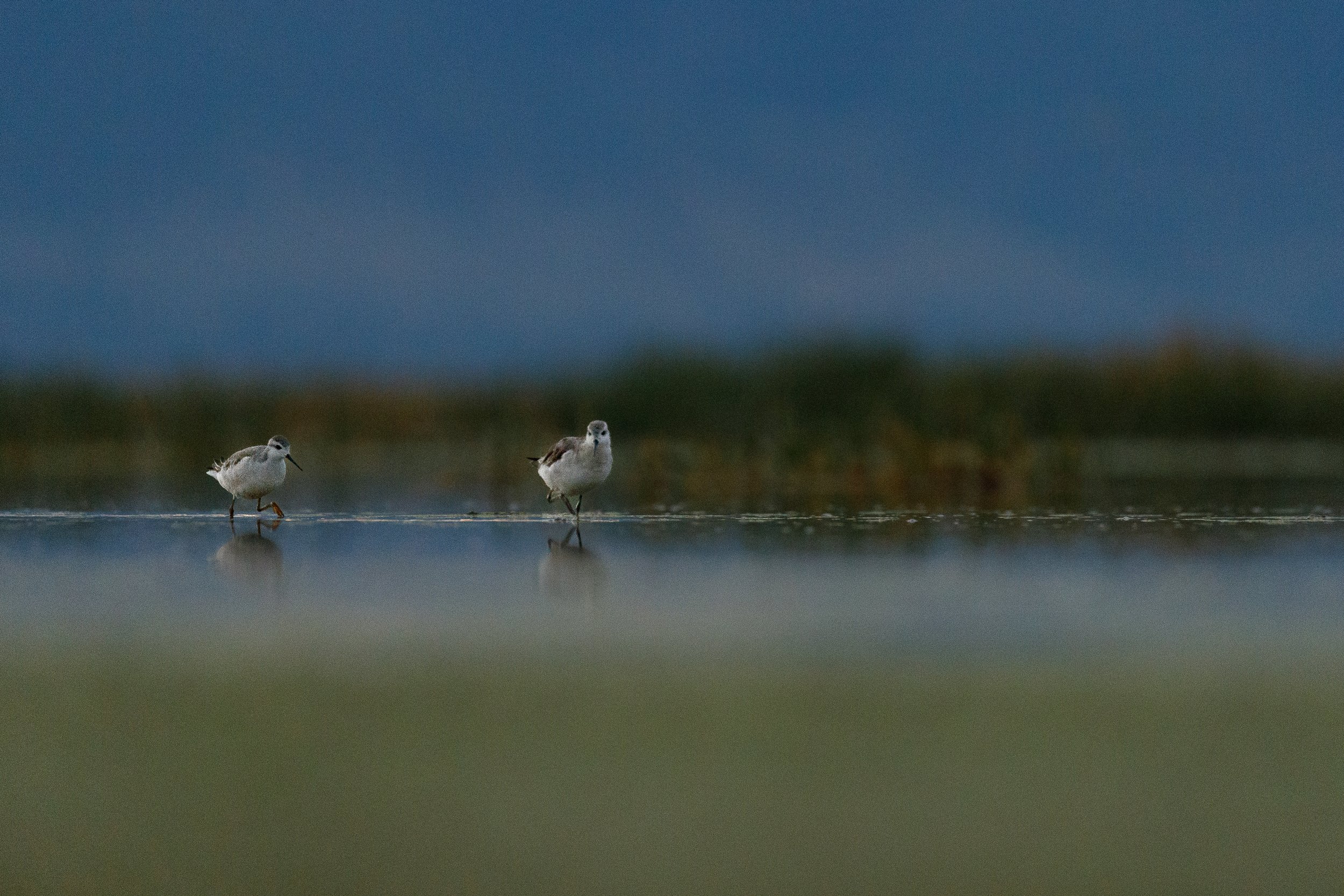

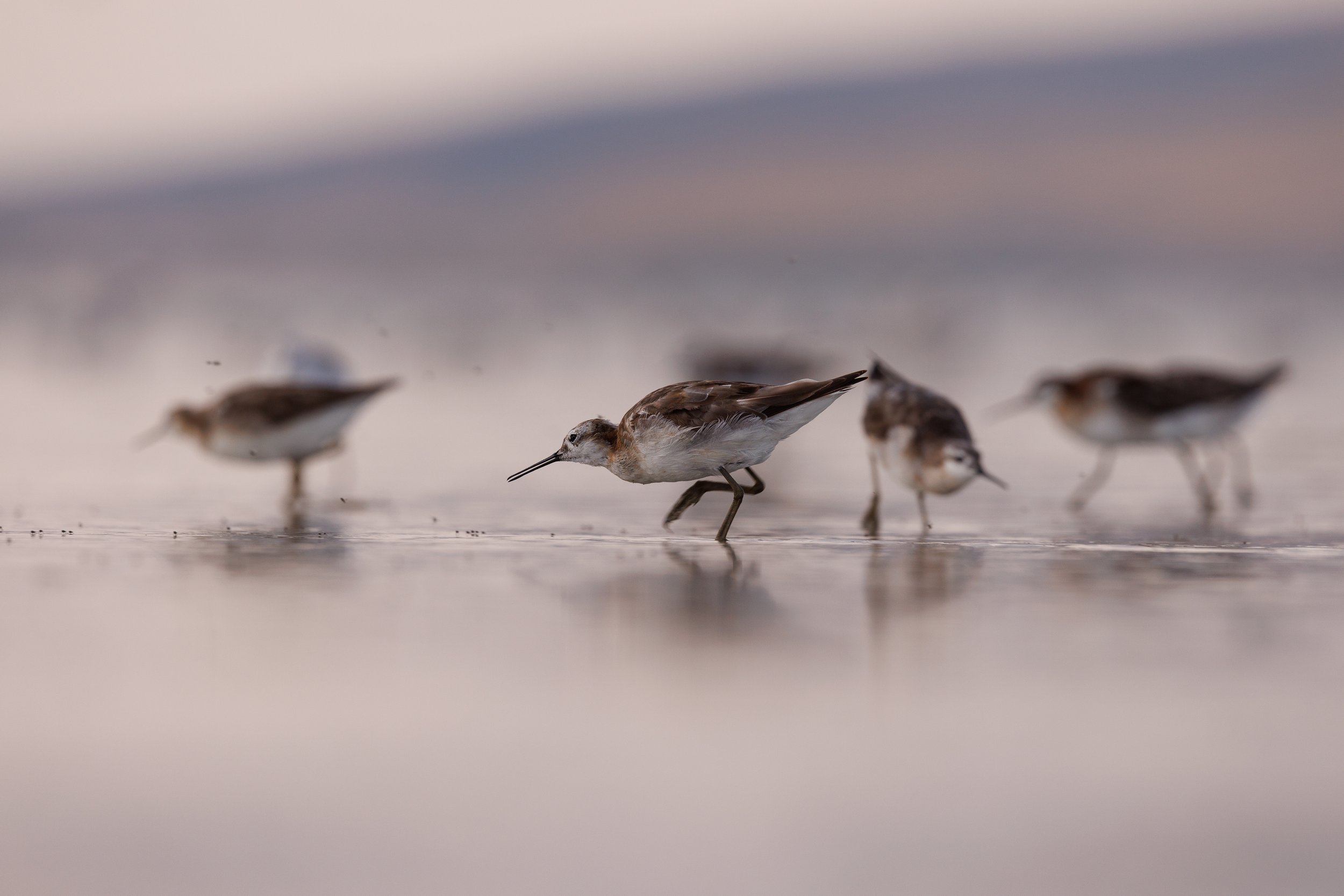
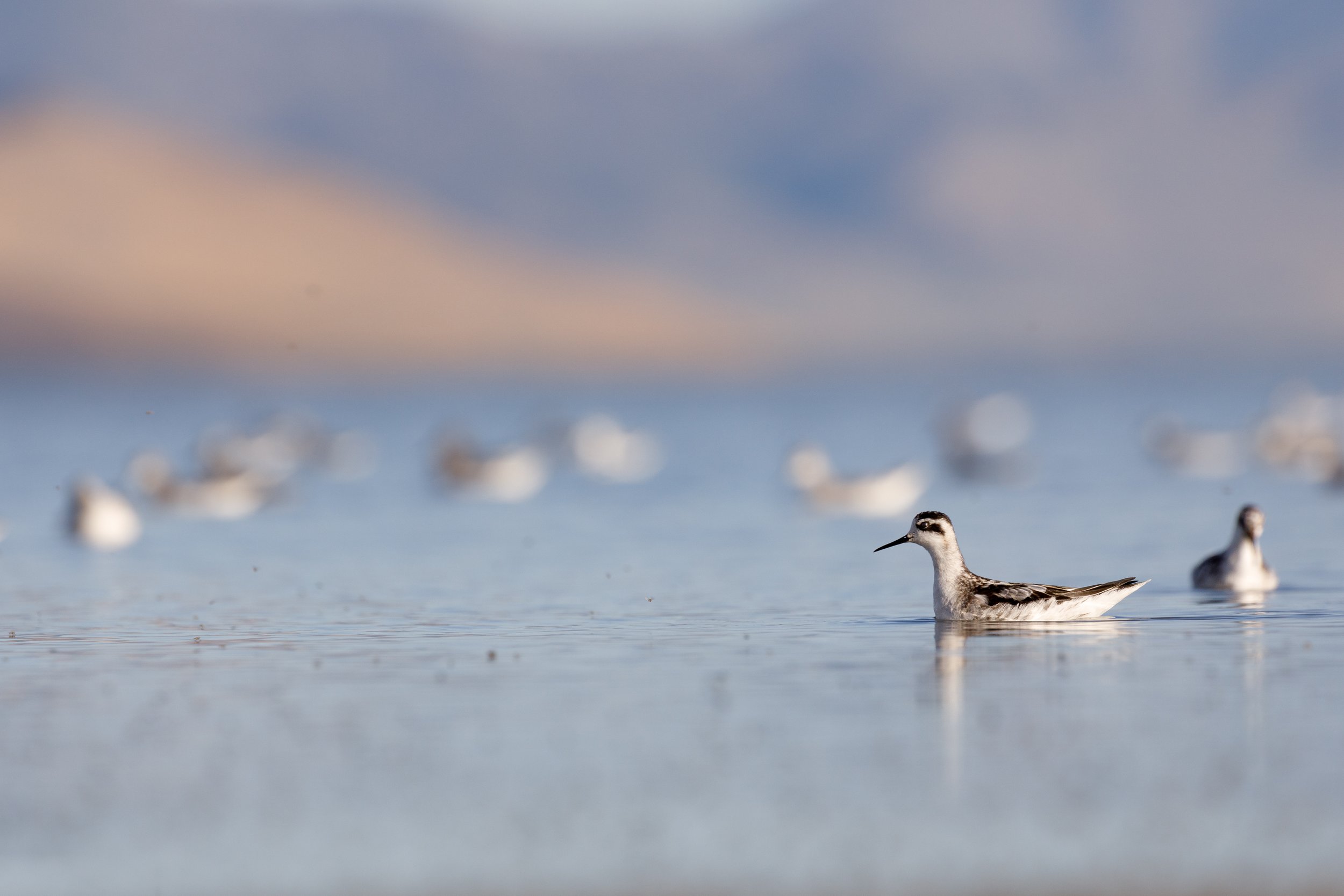

Phalaropes at Great Salt Lake by Janice Gardner.
This August, groups including Sageland Collaborative, Point Blue Conservation Science, National Audubon Society, state and federal agencies, and many community science volunteers came together to make an impact for these birds. The Intermountain West Shorebird Survey is a region-wide effort to census shorebirds across 200 sites in 11 states during peak spring and fall migration windows. This fall, hundreds of volunteers and partners across Utah counted 526,450 shorebirds. With this data, we now know exactly how important Great Salt Lake is, hosting the majority of the region’s shorebirds during fall migration. This knowledge helps scientists understand the migratory path of these birds, how they’re using the landscape, and can inform land managers and legislators so they can prioritize the conservation of these critical ecosystems. It is not only for shorebirds like Wilson’s Phalaropes, but it is also for ourselves. Through this work, the conservation and restoration of the habitats we all depend on is possible – humans and wildlife alike.
Special thanks to Emm Clark and Jaimi Butler for sharing their experience and expertise in support of these unique shorebirds and the communities they bring together.
Article by Alhondra Lopez
Group photos by Emm Clark & Jaimi Butler
Phalarope photos by Sierra Hastings & Janice Gardner
Alas y Manos: Conexión Cultural a Través de las Aves Playeras
Es un sábado por la mañana en agosto, el sol naciente ilumina la costa, y con cada paso recordamos que caminamos sobre las huellas de las aves playeras que nos trajeron aquí. El Gran Lago Salado se presenta ante nosotros con la bruma punzante que llena el aire y los colores pasteles que juegan sobre el agua; la presencia de vida en la tierra es vibrante. Llenamos nuestros pulmones con este singular aire salino y grabamos en la memoria el recuerdo brillante del paisaje. Es hora de contar aves playeras.
Falaropos cuellirrojos y Wilson alimentándose en el Gran Lago Salado. Foto de Janice Gardner.
Las aves playeras son seres fenomenales que nos alientan a aprender más sobre la interconexión de nuestras vidas con el mundo natural y las comunidades globales. Muchas aves playeras emprenden impresionantes migraciones, viajando miles de kilómetros a través del hemisferio para llegar a diferentes áreas de cría y no cría, lo que resalta en su resiliencia, adaptabilidad y notable resistencia. Además, las aves playeras desempeñan un papel vital en nuestros ecosistemas, contribuyendo a la biodiversidad de los lagos salinos, consumiendo billones de insectos y siendo indicadores significativos de la salud de nuestros ecosistemas. Además, como fuertes aves migratorias, también funcionan como narradoras que nos conectan con otros lugares y culturas. Las aves playeras son embajadoras entre comunidades; inspiran a los humanos a través de la observación de aves, el folklore y el arte, creando conexiones entre los seres humanos y la naturaleza.
Uno de estos narradores es el falaropo de Wilson, una pequeña ave playera que viaja casi 6437.376 kilómetros de lago salino a lago salino, conectando comunidades a lo largo del Hemisferio Occidental. Este increíble pájaro establece relaciones con las personas que viven y trabajan en estas áreas que van desde Canadá hasta la Laguna Mar Chiquita en Córdoba, Argentina.
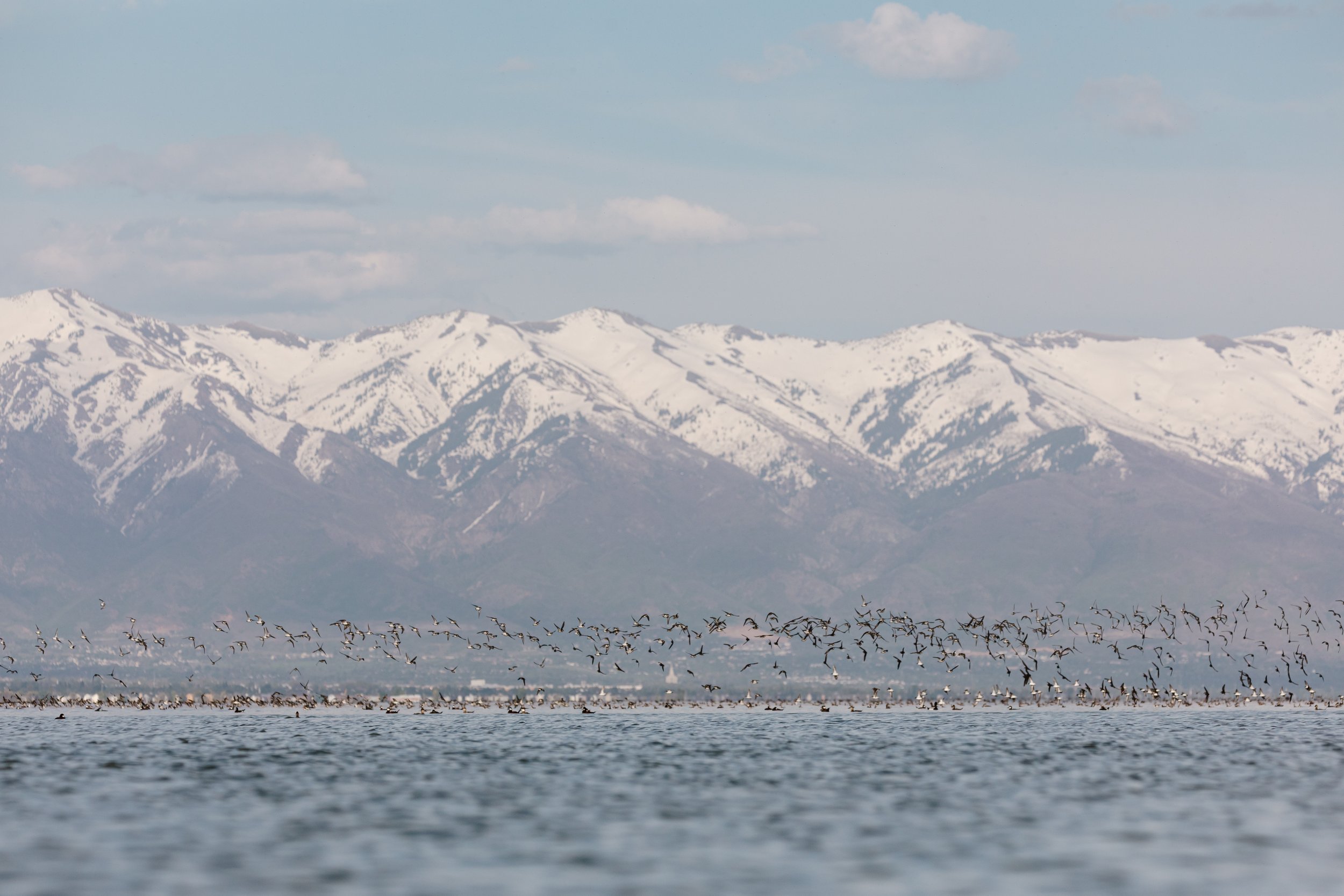


Butler (derecha) y Clark (atrás en el centro) en un paseo en barco por la Laguna Mar Chiquita. Foto de Jaimi Butler.
La ecóloga aviar de Sageland Collaborative, Emily (Emm) Clark, y Jaimi Butler, presidenta de la Junta Directiva de Sageland, viajaron a Argentina esta primavera para asistir a una reunión del Grupo Internacional de Trabajo sobre Falaropos, una colaboración multinacional que busca conservar y aprender más sobre las tres especies diferentes de falaropos. Para Sageland, es de particular interés fortalecer y expandir las conexiones entre nuestros hermanos lagos salinos y las personas que trabajan para protegerlos. Nuestras representantes también se enfocaron en el desarrollo de esfuerzos de conservación a escala de rutas migratorias para los falaropos. Este grupo ha estado generando impactos significativos en la conservación desde 2019 y está comprometido a fomentar conexiones y compartir experiencias entre diversas culturas y países, incluyendo Chile, Bolivia, Ecuador, Estados Unidos, Canadá y Argentina, en apoyo a la conservación de los falaropos y los hábitats salinos. Clark menciona que este grupo se formó para avanzar y coordinar acciones de investigación y conservación para los falaropos en el Hemisferio Occidental. “Hasta ahora, el grupo ha ayudado a aumentar nuestro conocimiento sobre los falaropos a través de encuestas coordinadas en múltiples regiones, ha iniciado estudios de rastreo para aprender sobre las rutas migratorias y ha apoyado el desarrollo de capacidades a nivel internacional.” Este grupo centra su trabajo en cuatro planes de acción: investigación, monitoreo, gestión de sitios y educación.
Para Clark, estar conectada con la vida silvestre y el paisaje también significa estar conectada con las personas.
“Me encanta ver que la gente se une para crear mejores condiciones tanto para las personas como para otros animales.”
Este amor por la educación, la investigación y la conservación llevó a Clark y Butler a recibir una beca de viaje del programa Linking Communities para asistir a la Reunión del Grupo Internacional sobre Trabajo de Falaropos del 26 al 29 de febrero de 2024 en Miramar de Ansenuza, Córdoba, Argentina. Esta reunión fue una oportunidad para conectar en persona con socios que trabajan en lagos salinos y otros hábitats críticos para los falaropos en el hemisferio occidental. Junto con los asistentes John Neill y John Luft de la División de Recursos de Vida Silvestre de Utah, fue una gran oportunidad para compartir experiencias y preocupaciones sobre el Gran Lago Salado, así como para discutir cómo apoyar mejor los esfuerzos de conservación a través de la educación y la divulgación.
Participantes de la reunión del Grupo de Trabajo Internacional sobre Falaropos posan frente a un mural del artista Franco “Vato” Cervato Cozza, que muestra la migración de los falaropos de Wilson entre lagos salinos hermanos. Foto de Emm Clark.
Butler admiró el elemento educativo del evento. Los jóvenes del programa de liderazgo ambiental Experiencia Ambientalia tuvieron la oportunidad de planificar, organizar y participar en esta reunión, empoderando a los jóvenes para proteger estos sitios y liderar proyectos de conservación. Esto fue significativo, ya que los adolescentes tuvieron la oportunidad de establecer contactos y aprender de profesionales, al mismo tiempo que escuchaban perspectivas únicas de culturas de todo el Hemisferio. Estas oportunidades brindan a la próxima generación de conservacionistas el conocimiento y las herramientas que necesitan para unificar a sus comunidades locales y actuar contra las amenazas a los falaropos, siguiendo el ejemplo de científicos, conservacionistas y amantes de las aves que destacan la importancia de las conexiones internacionales en la conservación de los falaropos.
Clark y Butler enfatizaron el papel de esta conexión internacional en la creación de conciencia a lo largo de todo el hemisferio, ya que lagos salinos como el Mono Lake en California, la Laguna Mar Chiquita en Argentina y el Gran Lago Salado en Utah son paradas críticas para las aves playeras. Aquí, en el Gran Lago Salado, el Falaropo de Wilson, el Avoceta Americano, el Estepario de Cuello Negro y muchas otras aves playeras dependen de la comida y el refugio que proporciona este ecosistema, y a cambio, estas aves impactan la riqueza de toda la comunidad. Janice Gardner, Directora Ejecutiva de Sageland Collaborative, destaca que mantener poblaciones saludables de aves playeras garantiza una buena economía y seguridad alimentaria para los residentes de Salt Lake. Un ejemplo de esto son los 52 millones de dólares que el avistamiento de aves local y la caza de aves acuáticas generan cada año.
Falaropos en el Gran Lago Salado por Janice Gardner.
Sin embargo, el futuro de estas especies de aves playeras es incierto. Los lagos salinos de todo el hemisferio, incluido el Gran Lago Salado, están disminuyendo debido al cambio climático, antiguas regulaciones del agua, el consumo humano y la industrialización. La desecación de estos lagos afecta negativamente a todo el ecosistema, desde las moscas de salmuera y las aves playeras hasta las comunidades humanas que viven en los márgenes de este entorno. En el Gran Lago Salado, las consecuencias de este declive incluyen la pérdida de alimento y hábitat para las aves playeras, así como un empeoramiento de la calidad del aire, lo que conlleva graves riesgos para la salud de los residentes de Utah.
Falaropos en Kennecott Outfall por Sierra Hastings.
Imaginen viajar miles de kilómetros de un lugar a otro durante años, y de repente esos lugares ya no existen. Clark nos dice que: “El Gran Lago Salado es una de las áreas de parada más importantes para los falaropos mientras se preparan para su migración al sur; necesitan comer mucho para tener suficientes reservas de grasa para mudar y hacer el viaje. Durante el invierno en EE. UU., es verano en Argentina, y la Laguna Mar Chiquita es uno de los sitios más importantes para los falaropos de Wilson. Allí pasan su tiempo descansando y alimentándose antes de volar de nuevo al norte para reproducirse, y el ciclo continúa.” Este es un ciclo de conexión entre lugares, hábitats, cultura y patrimonio. Las aves playeras pueden conectarnos con otras culturas, y aunque no hablemos el mismo idioma ni compartamos tradiciones, todos estamos unidos por estas aves únicas y la salud de los lagos salinos de los que dependemos.
Sí podemos asegurar la longevidad del Gran Lago Salado, podemos garantizar la salud de los residentes de Utah, nuestros lazos culturales y un futuro de biodiversidad en todo el Hemisferio Occidental.



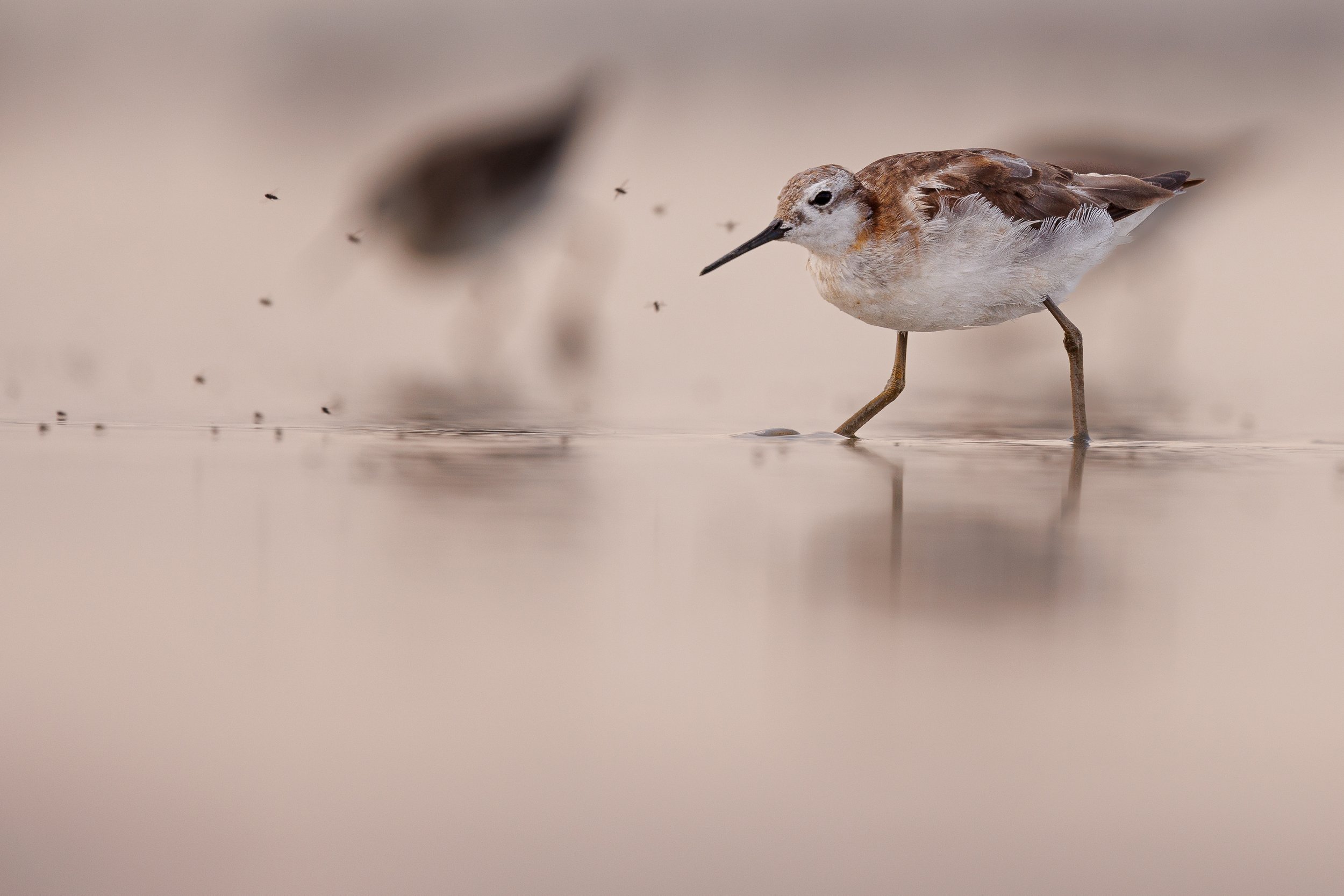

Falaropos en el Gran Lago Salado porJanice Gardner.
Este agosto, grupos incluyendo Sageland Collaborative, Point Blue Conservation Science, la Sociedad Nacional Audubon, agencias estatales y federales, así como muchos voluntarios de ciencia comunitaria, se unieron para hacer un impacto en la conservación de estas aves. El Censo de Aves Playeras del Oeste Intermontano es un esfuerzo regional para contar aves playeras en 200 sitios en 11 estados durante las ventanas de migración de primavera y otoño. Este otoño, cientos de voluntarios y socios en Utah contaron 526,450 aves playeras. Con estos datos, ahora sabemos cuán importante es el Gran Lago Salado, albergando más de la mitad de todas las aves playeras de la región durante la migración de otoño. Este conocimiento ayuda a los científicos a entender la ruta migratoria de estas aves, cómo utilizan el paisaje y puede informar a los administradores de tierras y legisladores para que prioricen la conservación de estos ecosistemas críticos. No solo es importante para aves playeras como los falaropos de Wilson, sino también para nosotros mismos. A través de este trabajo, la conservación y restauración de los hábitats de los que todos dependemos es posible, tanto para humanos como para la vida silvestre.
Un agradecimiento especial a Emm Clark y Jaimi Butler por compartir su experiencia y conocimientos en apoyo de estas aves playeras únicas y las comunidades que unen.
Artículo y traducción por Alhondra Lopez
Fotos de la reunión por Emm Clark y Jaimi Butler
Fotos de falaropos por Sierra Hastings y Janice Gardner












